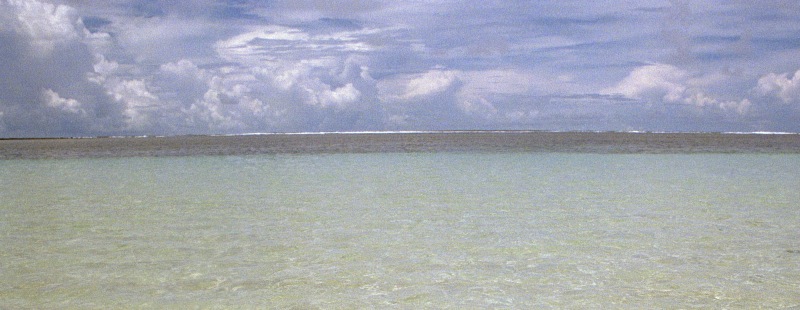By: Crispin Maslog
Send to a friend
The details you provide on this page will not be used to send unsolicited email, and will not be sold to a 3rd party. See privacy policy.
A rectangular table sits in the open air a few meters from the shore, around which a dozen chairs are neatly arranged. And beyond the fine white beach sands, the blue ocean stretches for miles into the horizon.
This idyllic image dominates the materials announcing the 3rd International Conference on Small Island Developing States on 1-4 September in Apia, Samoa in the southwest Pacific.
But the issues that this UN-sponsored conference will tackle are anything but romantic. The conference will focus the world’s attention on this group of island countries that remain a special case for sustainable development in view of their unique vulnerabilities. The issues are a matter of survival for small island states in this century.
Attention on small islands
The conference will bring together heads of state and world leaders together with stakeholders from member island states, civil society, private sector, environmental groups and international development organisations. Organisers say some 2,000 delegates have registered so far.
Samoa Prime Minister Tuilaepa Aiono Sailele Malielegaoi says his country wants the world to save the small island developing states (SIDS) through partnerships. “Partnerships must be encouraged at all levels, national, regional and international, including among SIDS.” [1]
The gathering will seek to renew political commitment from member nations and potential partners, and identify emerging challenges, opportunities and priorities for the sustainable development of SIDS including those that will be included in the post-2015 UN development agenda.
SIDS are low-lying coastal countries that share common challenges — small but growing populations, limited resources, remoteness, susceptibility to natural disasters, vulnerability to external shocks, excessive dependence on international trade, and fragile environments. [2]
The UN lists 52 SIDS from three geographic regions—the Caribbean, the Pacific, and the AIMS, which consists of Africa, Indian Ocean, Mediterranean and South China Sea. The 20 island nations in the Pacific also have their own regional body, the Pacific Islands Forum.
The challenges facing these small island states are indeed daunting and they need gargantuan financial and logistical resources to meet them. The UN and all the island states have decided on the strategy of partnerships to maximise limited resources.
S.A.M.O.A. pathway to sustainability
Partnership dialogues intended to strengthen existing partnerships and promote new ones will take place on 30-31 August in the run-up to the conference. Out of dozens of critical issues facing these beleaguered island states, they decided to focus on six priority themes.
These priority themes are (1) sustainable economic development;(2) climate change and disaster risk management; (3) social development in SIDS, health and non-communicable diseases, youth and women; (4) sustainable energy; (5) oceans, seas and biodiversity; (6) water and sanitation, food security and waste management.
These themes are contained in the draft conference outcome document, the SIDS Accelerated Modalities of Action (SAMOA) Pathway, prepared by the UN Department of Economic and Social Affairs.
The SAMOA Pathway outcome document, in my opinion, rightly highlights sustainable development and climate change-disaster risk reduction as the two most important issues for these small island states.
I also fully support the idea for the private sector to come into the picture. For too long have we depended on government taxes to fund development projects.
For development to be sustainable, we need the expertise and funding of the private sector as well as “intergovernmental cooperation, international cooperation and the active engagement of both the public and the private sectors.” [3]
Climate change, the document says, is “one of the greatest challenges of our time, and we express profound alarm that emissions of greenhouse gases continue to rise globally… climate change and sea-level rise continue to pose a significant risk to small island developing states and their efforts to achieve sustainable development and, for some, represent the gravest of threats to their survival” and loss of territory. We could not agree more.
I must note, however, that the rest of the priority themes included in the partnership dialogue agenda – food security, water, sanitation and waste management; sustainable energy; social development, health and non-communicable diseases; youth and women; and oceans, seas and biodiversity – are buried deep in the outcome document, from the middle (Points 47 to 72) to the end.
The outcome document gives the impression of being loosely organised and does not follow the prioritisation of themes in the dialogues.
Rocky pathway to prosperity
The issues are complex and mind-boggling and the proposed solutions are complicated. But as the outcome document says, the goal “can only be achieved with a broad alliance of people, governments, civil society and the private sector all working together to achieve the future we want for present and future generations.”
The stakes are high and the SAMOA Pathway may turn out to be rocky. But with partnerships, these small island developing states hopefully will survive and prosper.
Crispin Maslog is a Manila-based consultant for the Asian Institute of Journalism and Communication. A former journalist, professor and environmental activist, he worked for the Press Foundation of Asia and the International Rice Research Institute.
Link to the 2014 UN Conference on Small Island Developing States
This article has been produced by SciDev.Net's South-East Asia & Pacific desk.
References
[1] UN Department of Public Information Press Release on 2014 UN Conference on Small Island Developing States (25 September 2013)
[2] Wikipedia Small Island Developing States (accessed 23 August 2014)
[3] United Nations Draft outcome document of the third International Conference on Small Island Developing States (17 July 2014)














